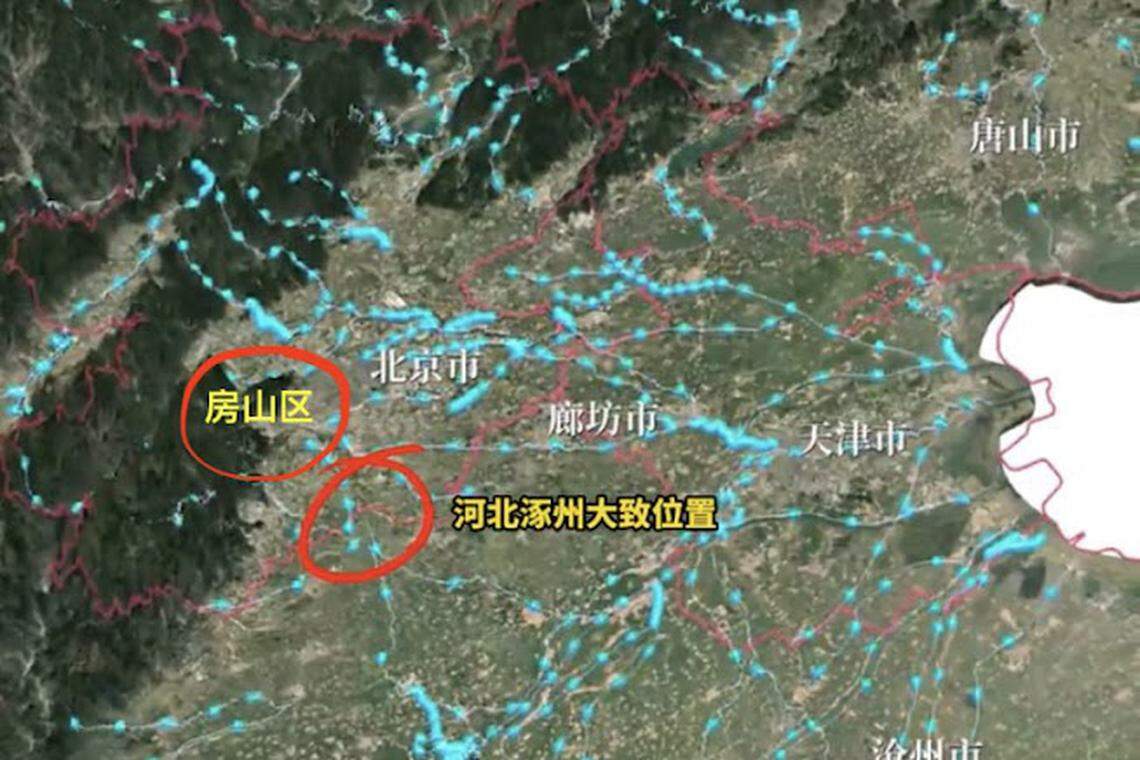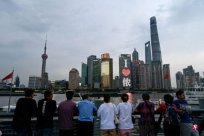
After four days of strong strength of four days, 70 hoursTo rain, Beijing finally relieved the heavy rain yellow warning at 7:30 am on Wednesday (August 2). The round of precipitation in North China was also close to the end.
Although the rain stopped, the flood disaster in Luzhou and other places in Hebei was still continuing. As of Tuesday (1st) at 10 am, the number of affected people in Luzhou was more than 130,000.Still waiting for rescue.
How heavy rain in Beijing?
According to the statistics of Beijing Meteorological Observatory, the value of rainfall recorded in Beijing this time is 744.8 mm, which is the highest rainfall in Beijing with instrument measurement records in 140 years.
In fact, the summer heavy rain occurred in Beijing.From the Yuan Dynasty to more than 600 years in 1949, there were as many as 437 floods in Beijing, which is equivalent to an average of once and a half years. The largest of which occurred in 1939, with 40 days of rain.
In recent years, many people have been impressed by the "July 21" extremely heavy rain in 2012, recorded to the maximum rainfall of 541 mm, causing a disaster in 1.6 million residents, and 79 people were killed.

Before "July 21", Beijing still twice in 2005 and 2008.Among them, the heavy rain on July 23, 2005 killed the two, waterlogging in the city, and a large number of houses collapsed; the heavy rain on June 13, 2008 caused nearly two meters deep in the local area of Beijing, and multiple subway stations were temporarily blocked.
After 7 · 21 ", there are also heavy rain.In 2016, Beijing's "July 20th" heavy rainstorm lasted 55 hours. The average process of the city was 215 mm, and the city transferred nearly 16,000 people.
But whether it is "July 21" in 2012, "July 20" in 2016, or this year's heavy rain, the most serious affected are Mentougou District and Fangshan District in southwestern Beijing.
Is it precautions?
Mentougou District and Fangshan District belong to the Yongding River Basin. The Yongding River has been named "Wu Dinghe" because of its historical flooding of the river.The Chinese government has built reservoirs in the upper and reaches of the Yongding River since the 1950s, and has set up pan -area in the lower reaches, which has basically solved the problem of flooding.
As for the urban drainage system, Li Yuhong, the former chief engineer of the Hehu Management Office of the Beijing Municipal Water Affairs Bureau, introduced to Caixin.com in 2012 that Beijing's Rainwater Pipe Network was not built in the same era, but the overall drainage capacity was low.It is not commensurate with Beijing's urban development."Building transportation has developed rapidly, but the landing is far away."
According to Xinhua News Agency, Beijing has learned lessons after "July 21" to accelerate the upgrading of flood control engineering facilities and emergency management levels.In 2013, the dredging of the 2061 kilometer pipe network was completed, and the upgrade and reconstruction project of the rainwater pump station in the central urban area was launched since 2013.
In 2016, Beijing's "July 20" rains occurred the next day. Beijing issued Beijing in Beijing: Four years ago, the flood raging place is now orderly.In order to highlight the progress of the Beijing Flood Control System.

In terms of policy, the Ministry of Housing and Construction of China issued a technical guide to sponge city construction in 2014, and Beijing was listed as one of the pilot cities.In the same year, Beijing also revised the Beijing Flood Prevention Emergency Plan and revised it again in 2018.
The Fangshan District, which is often affected, also transferred the villagers from the low -lying field to the high -terrain and convenient drainage houses through multiple population migration.
Although Beijing has made many preparations in the past ten years, this time the heavy rainfrade mountain area has been affected again.According to the news released by the Fangshan District Government at noon on August 1, 60,000 households in the district were out of power, and 3,410 villages in 28 villages had a power outage.Three of the 12 people who killed Beijing this time from the rainstorm were from Fangshan District.
Among the nine people who were killed in Beijing, four were from Mentougou District, four in Changping District, and one in Haidian District.Except for Haidian District, the other three places are suburbs.
From the perspective of the distribution of the victims, the drainage system in Beijing's urban area may withstand the test, but the terrain is steep and the flood rate is fast. The western Beijing region that cannot intercept flood through engineering has become the hardest hit area.
Flood to the surroundings?
Another thing that becomes the hardest hit area is, Located in the lower reaches of the Beijing River.On the 31st, after the flood reference in Beijing, the water level in Lizhou rose rapidly that night, with more than 130,000 people affected.
Under the entry of "Dazhou Flood" on Weibo, a Hebei netizens expressed their anger in the downstream flood discharge in Beijing: "People in Beijing are fate, Beijing -Tianjin -Hebei regions, Hebei people in HebeiIsn't your life fate? "
Regarding whether Beijing should flood downstream, Weibo and Hebei netizens on Weibo are divided into each.Netizens in Hebei believe that they are affected by floods in Beijing; Beijing netizens believe that they can only "finish the egg together."

In this regard, Hu Xijin, the former editor -in -chief of the Global Times, posted a Weibo on the evening of August 1st, refuting that the Dazhou was flooded as "flooding to Puzhou in Beijing", and said that this was "anti -common sense."
He said that this statement is "the unity of flood resistance is a kind of damage, and it is also a provocation of regional barriers", and explains that the flood overflowing upstream will inevitably be marched down the river channel and leaked downward.Beijing has no ability to stop the floods that cannot be stopped at all.
Beijing's downstream flood discharge is indispensable, but the problem is that the interval from the flood discharge notification to the locks to put water is too short, and the downstream is too late to prepare or transfer.
The above -mentioned netizens in Hebei also said: "A few hours after the notice, it was leaked at 11 o'clock in the middle of the night. What would the people fly?The people in the village can't receive the notice at all! "
Qi Wan, the villager of Beiyuanzi Village, Shezhou City, told the Southern Weekend that the village leaders notified each household to clean up things and wait for the evacuation, but did not wait for the formal officialnessThe water level accelerated.At 10 pm to one person, it rose to 3 meters at 2 am, causing hundreds of people in the village to be trapped.
Due to the insufficient official rescue workers, the trapped Puzhou residents can only go to social media for help.sinceFrom August 1st, a lot of information on Qianzhou for help appeared on Weibo.
As of press time, there are still residents of Lizhou waiting for rescue.The Weibo user "Girl who eats Pikachu" posted at 7 pm on August 2, saying: "The community is more than three meters deep, and the water is broken and the electricity is broken.src="http://www.kzaobao.com/uploads/allimg/230803/00550925h-4.jpg"/>
The folk rescue power also wants to support Puzhou, but it is stuck on the "invitation letter".
According to the southern weekend report, volunteers of a number of civil rescue organizations said that the private rescue team in the field needs to issue an invitation letter to the emergency management department of the incident before cross -provincial rescue, and then to the emergency emergency to the territoryManagement department reports.After being approved, the rescue team can only start.
The two Shanxi rescue teams were originally planned to support Beijing because the procedures were not rejected by the staff of a local emergency administration; a Shandong rescue team saidOpen the invitation letter.
Some rescue teams may also ask for invitation letters separately from Lizhou villages and streets, but the official seal of the local government was not found by floods.
Disclosure of crisis information
Although there are residents of Lizhou are still trapped, if you do not actively search on Weibo, you will not be able to see it.Hot search entries, a Weibo with the topic of Lizhou wrote: "I have never been so restricted."
and currently appear on Weibo hot search.How to do personal health protection after flooding. "
The entries that can be selected for hot search in the past two days are also full of positive energy: "Beijing -Tianjin -Hebei Rainstorm and mutual assistance", "Daizhou traffic police holding a baby transfer in the rain""Dangerous Zone", "Railway Paying 400 Liang Liang Taxi Fit Sending Traveling Passengers", "Old Man crying for the Armed Police Crown Diseases for Rating" ...
"Beijing Mentougou Status", "Floods lead to a lot ofUnder the entry of the car was washed away, there was only a symbolic Weibo, and there was no other discussion.

After the "July 21" heavy rain in Beijing in 2012, Wang Xizhinc, a professor at the School of Law School of Peking University, pointed out that the government did not make a timely notification of the changes in disaster conditions and road conditions information in a timely manner.It shows that the government is still accustomed to thinking in crisis response and information disclosure, and still does not trust the people.
In the past 11 years, in the face of the heavy rain in the current danger coefficient, some netizens in Hebei and rural villagers in Lizhou said that floods came faster than flood discharge notices, indicating that the speed of the front line disaster information transmission is still the speed of transmission of information information transmission of frontline disaster information information.Not enough time, the public missed the evacuation opportunity and was in trouble.These regrets can make up for the hot search entries full of positive energy on Weibo.At the same time, foreign volunteers want to support across provinces but have no "invitation letters", which also highlights the disadvantages of bureaucracy.
Extreme weather incidents have become more and more frequent in recent years. In addition to upgrading the urban drainage system and upgrading rainwater pumping stations, the official must also summarize all aspects of disaster relief work.After all, people's voice is like floods, it should be sparse and not to block.


